IB DP Art Exhibition 2020
Every year, the IB DP Visual Arts students get to share their work with friends and family at the AV Art Exhibition. This year, we were unable to host this event due to COVID-19 so we thought we would bring it to you online. Enjoy!
Galina
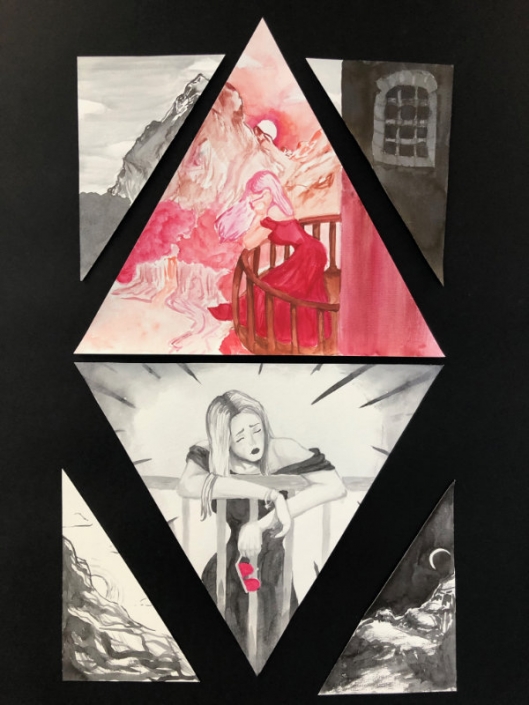
Fairytale
This work shows a princess, following the rules of a fairytale and waiting for her prince. This artwork does not argue if that is right or wrong, but shows how cliche and boring this role is. She is spending her time, separated from the outside, fully aware of her rose-colored glasses, but she does not want to change her life, because she believes in the end her prince will arrive. This work is about understanding your flaws but following through with your beliefs anyway.
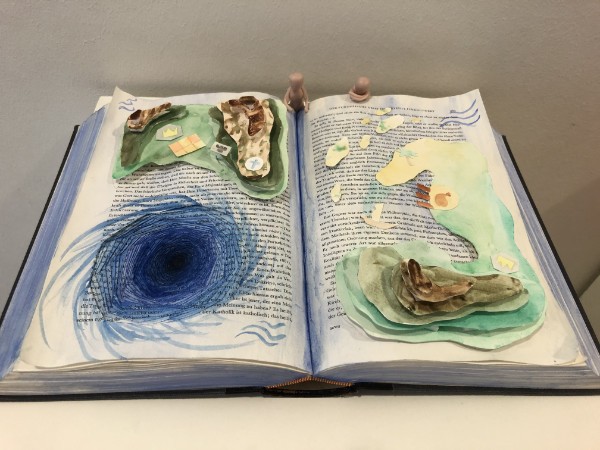
The Story of Two Kingdoms
The work depicts a story happening directly inside a book, inspired by the 3D effect of children’s pop-up books. It is a general, invented story about 2 kingdoms on different continents at war, and the two people looking at the map are navigating the story. It represents the visualization book readers and how people that are invested in the story literally “see” the events unfold in front of them. The work shows not a page, but the full story, shown through the whirlpool digging into the book.
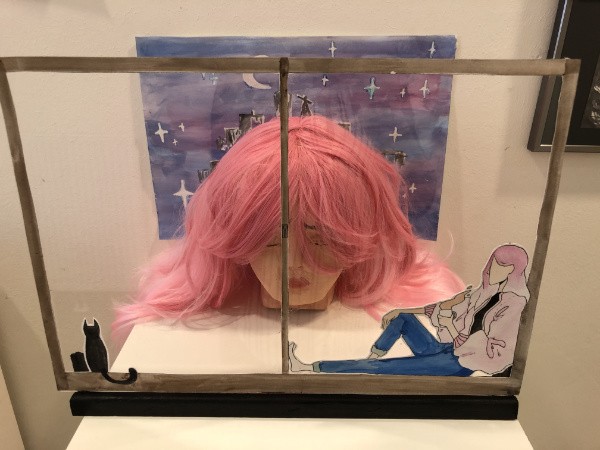
Me-time
This work represents a distressed character in a moment of self-reflection. Instead of appreciating the view in the window she is absorbed by emotions and her view is obscured by her own 3D head. She is unable to understand herself, which is represented through the use of different mediums showing the broken state of the character. The pleasant pastel colors are representative of a safe, calm atmosphere but the distortion of the face represents the characters dissatisfaction with herself.
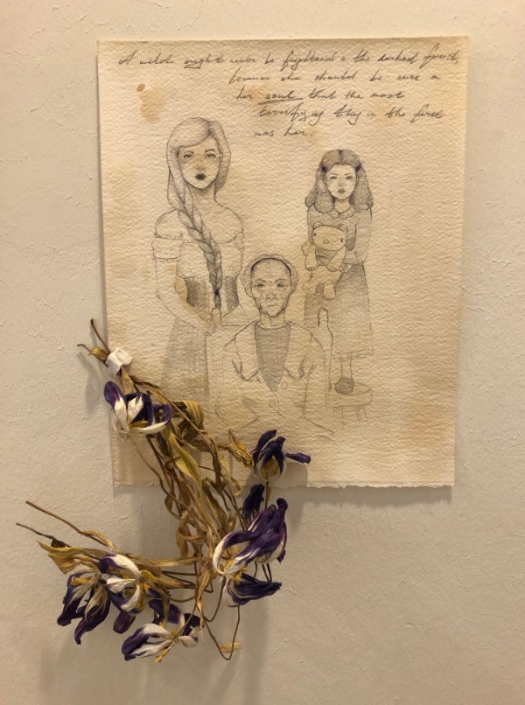
A Witch Ought Never Be Frightened, Even in the Darkest Forest
This work was inspired by Terry Pratchett’s quote in his book Wintersmith: “A witch ought never be frightened, even in the darkest forest, because she should be sure in her soul that the most terrifying thing in the forest was her”. The illustration focuses on three generations of witches and their family connection. It’s about passing tradition and finding strength through your roots. This is a family style portrait with dead tulips symbolizing rebirth of family traits through generations.
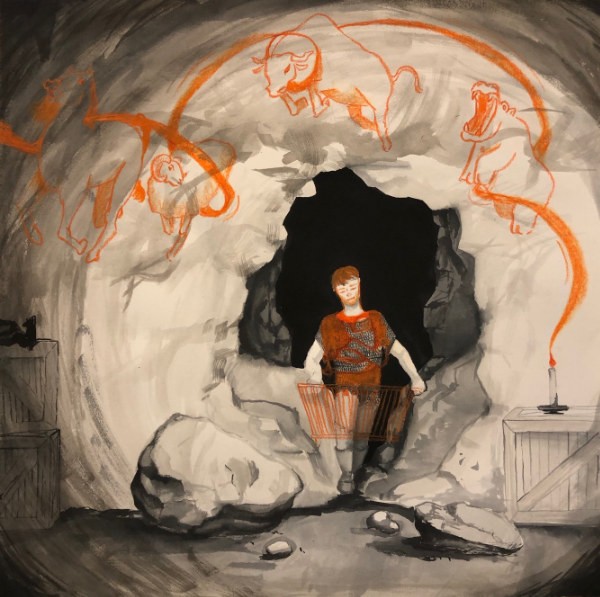
Where is My Cow?
This work is an illustration of a moment from the book “Thud!” by Terry Pratchett, this is the apotheosis and I felt deeply touched by this moment. The black-and-white and orange parts of the work represent two parts of reality - one of a man barely escaping death, another of him reading a bedtime story to his son. My interpretation shows how parental love can help one be saved from near death. The animals from the book “Where is my Cow?” (part of the plot) represent father and son’s connection.
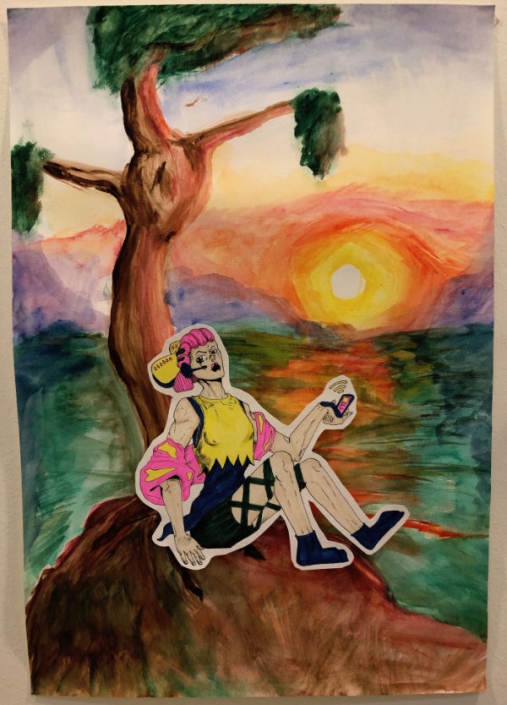
Sunset, 2120, Colorized
This artwork was influenced by two artists with different art styles; Arkhip Kuindzhi’s detailed landscapes and Hirohiko Araki’s bold and thick-line characters. The narrative behind this work focuses on a time traveler gone back in time, witnessing a beautiful colorful sunset in a still nature filled world. It raises the concern of losing all of the world's natural beauty to brighter, slicker technology. The message does not take any sides but reminds people to appreciate beauty now.
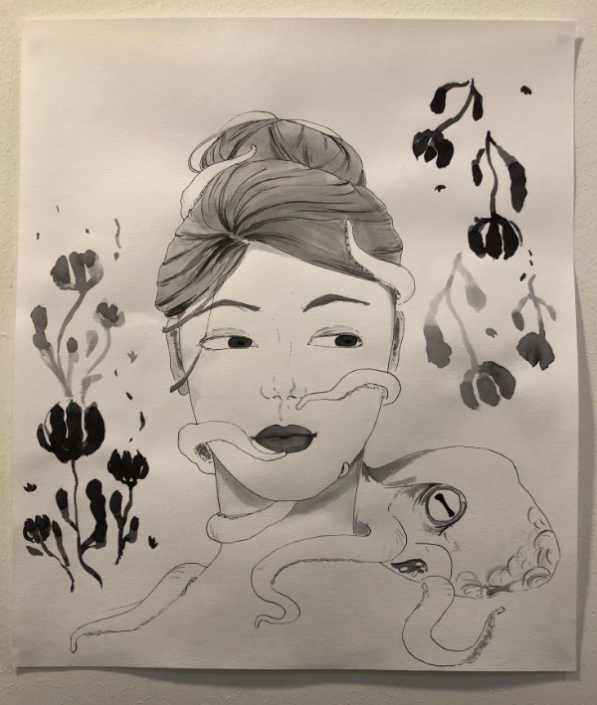
Ося
This work is a “title” illustration of my Mother’s short story called “Ося” (a pet name for an octopus) about an unlikely friendship of a girl and an octopus. It focuses on a girl finding a way to communicate with the creature and later coexist with it by hiding it in her hair. This is reflected in the artwork through their friendly interaction. I used ink as a medium because it resonates well with the biological nature of the octopus. The artwork captures the overall essence of the story.
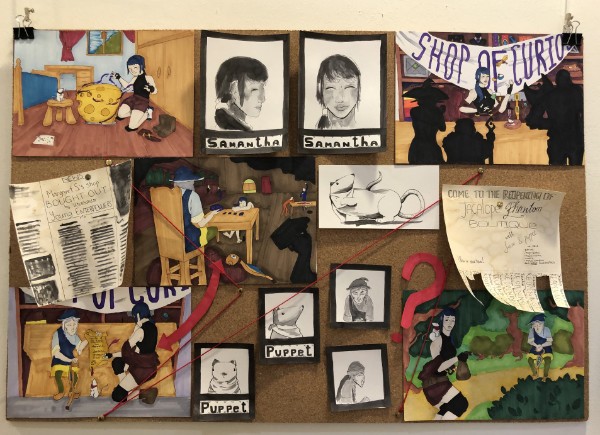
The Curious Case of Sam & Puppet
By making this work an investigation board I tell a story of an adventure from a different perspective; from the view of the outsider. The red yarn line connects the events in a chronological order and other elements around explain the details of the story. It’s an open-ended narrative about the life of two adventurers paying their gambling debt through an illegal money scheme - hence the research board. This work was influenced by mainstream fantasy genre games such as Hearthstone.

A Night Out
The aim of this artwork is to make something odd seem normal and conventional. The main character believes he is a duck and worships ducks as gods, he even has his duck family. However, he still does human activities (eating instant noodles for instance), regardless of his belief in being a duck. This ideological juxtaposition and the absurdity of the situation combine to make a nice, wholesome atmosphere with an element of humor. Overall the work encourages self-care in any form it takes.
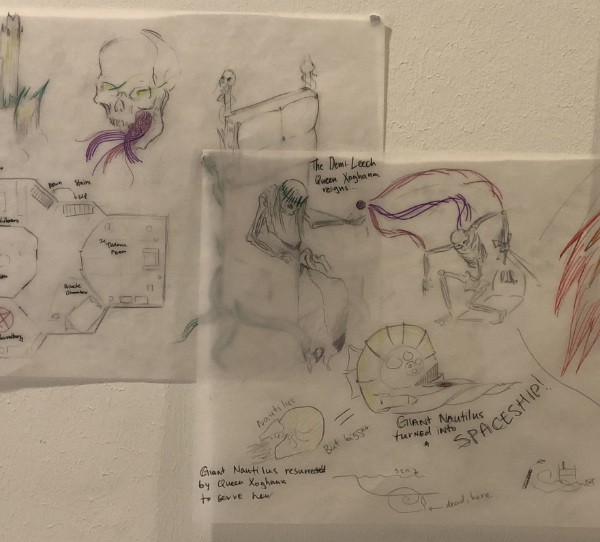
Queen Xoghana’s Expansion: Space Program
This artwork is supposed to be a representation of a brainstorm of a concept artist. It shows a character, who is developing their ideas through small drawings and concepts. The ideas in the brainstorm were inspired by the tabletop game Dungeons and Dragons - even the design of the spaceship is very close to the ‘spelljammers’ from the game. Another aim was to combine different genres together fantasy and sci-fi. The story is of an undead queen and her undead warriors.
Reo
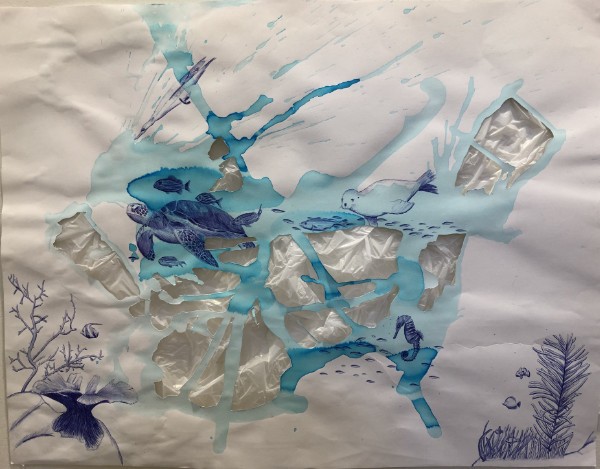
Ocean Lives
Plastic pollution harms the many living marine species, represented here in great detail using pen to show their unique beauty, while the plastic seeps in from behind. This sends a clear message to viewers to be conscious of their plastic waste. This piece uses only blue to represent the natural color of the ocean, as well as representing the sadness of the diverse species. The composition was derived from drops of blue watercolor spontaneously blown across the paper.
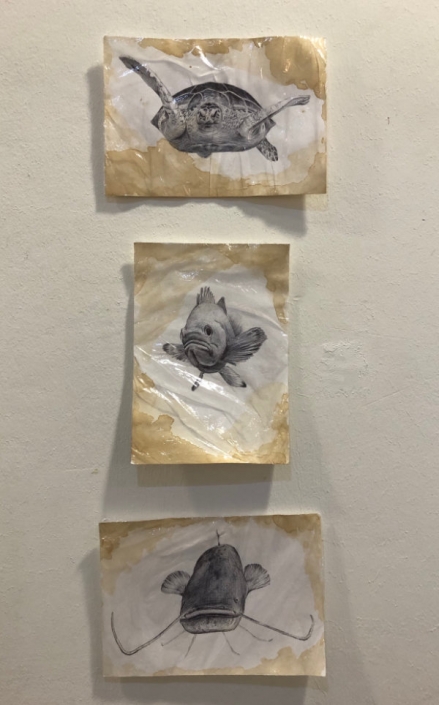
Swallowed Lives
This piece shows sea creatures surrounded by polluted water and floating plastics. Individual sea creatures are represented in great detail using a pen to show how fascinating, unique, and beautiful they are. Coffee stains create an ugly vignette, which visually helps to frame each creature as it would in photography, but also surrounds and traps them. The plastic cling film over the surface furthers the feeling of entrapment.
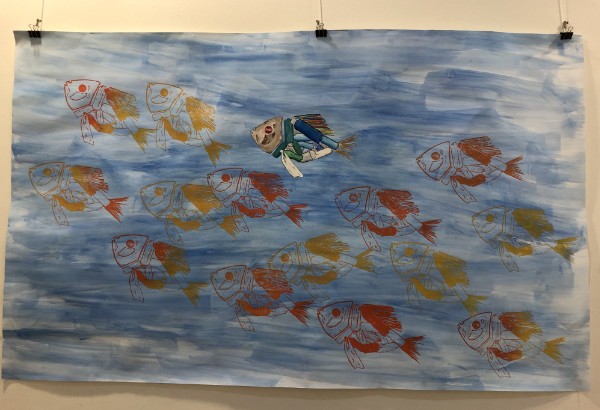
School of Fish
This piece shows how fish look when they coexist with the garbage in abstract terms. They have skeletal and deathly living appearance due to the use of lino-cut. The piece is large to envelop the viewer and make them feel as though they are in the ocean. Watercolor is naturally used to represent the water. Lino-cut printing is used to repeat the fish to create a school, and acrylic paint (plastic paint) is used to paint the focal-point fish made of plastic objects.
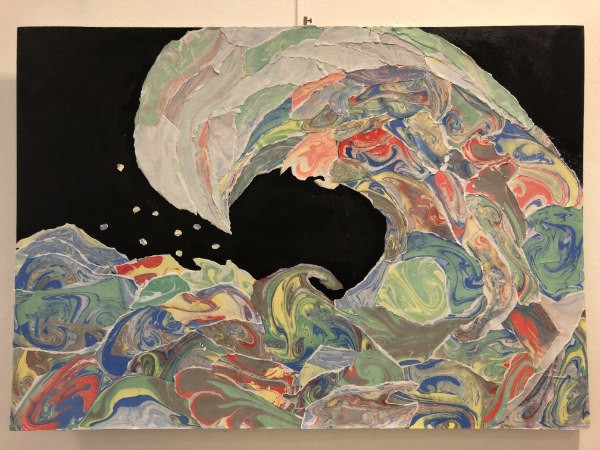
The Wave
Inspired by the Great Wave of Kanagawa by Hokusai Katsushika, this work combines his general composition with the added appearance of an oil spill. Oil spills are an environmental catastrophe that endangers the lives of ocean species and destroys their ecosystem. The scale of the wave represents the amount of destruction caused and it is swallowing all the lives in the ocean.
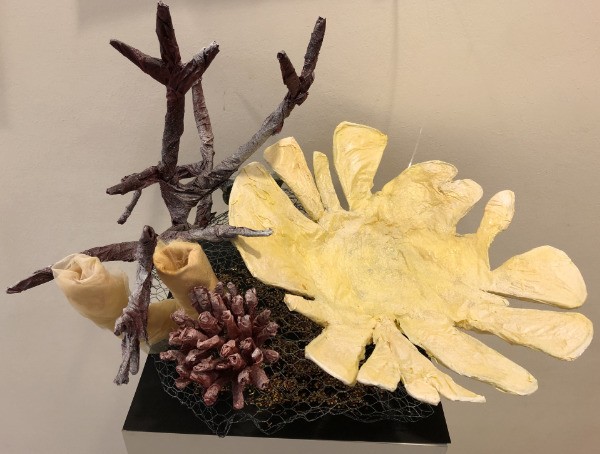
Fading Coral
Inspired by Christine and Margaret Wertheim’s Crochet Coral Reef, this piece represents the beauty and fragility of coral. Tissue paper and fabrics were chosen because the corals are delicate and vulnerable. The spritz of white spray represents bleaching. The beads underneath represent the loss of their vibrancy and eventually lives.
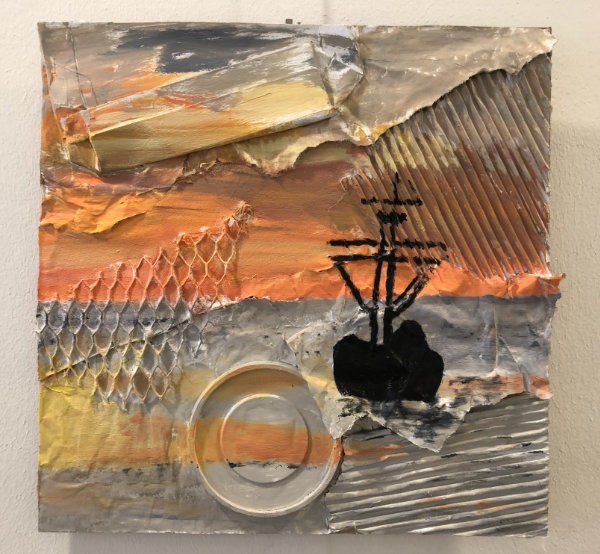
Ship in the Harbor
Inspired by the many beautiful oil paint seascapes of the Impressionists, this piece puts a twist on the traditional seascape. The collage composed of pieces of human garbage under the paint represents how people ignore the problem when it is hidden beneath the surface. When you don’t look closer you only see the beautiful view. The yellow and orange light represents the bright hope and possibility that we can still save the sea.
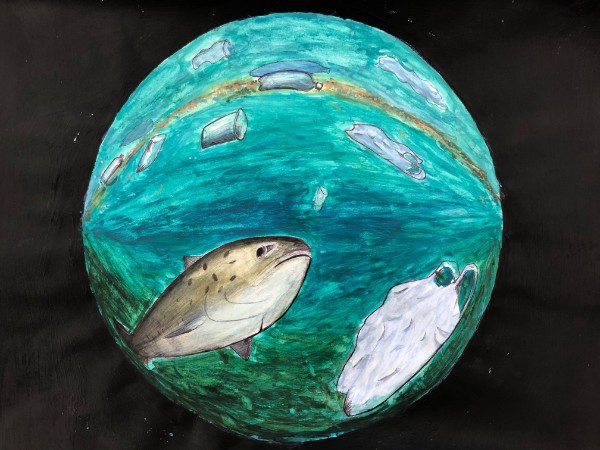
Fish Point of View
Many contemporary artworks exist that depict water pollution from a human point of view. However, as we know, fish see different from us. The “fisheye” lenses on our cameras give us some idea of how fish may view the world. As they see objects larger at the center, the garbage in their environment would appear even bigger than it actually is. We need to realize that water pollution is much more severe for fish than we can imagine, and we should try seeing from their perspective.
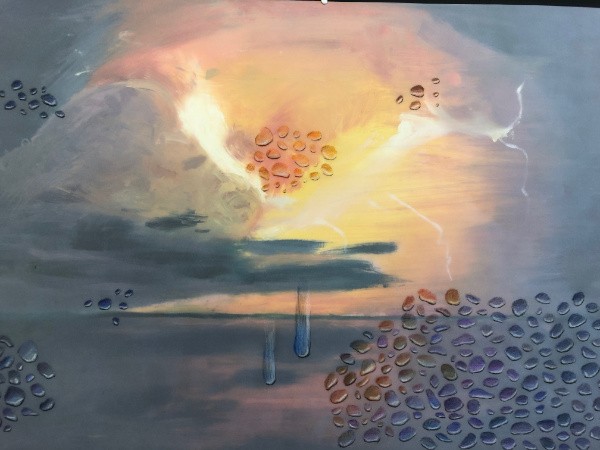
Natural Phenomenon
Partially inspired by Hans Haake’s Condensation Cube, this piece explores the many forms water takes in nature. The oil paint gives richness, and depth to the nighttime seascape. The tracing paper represents a barrier that human put up to distance themselves from nature. The natural phenomena represents emotions such as sadness and indignation, as the intense weather is a result of human-caused climate change.
Niklas
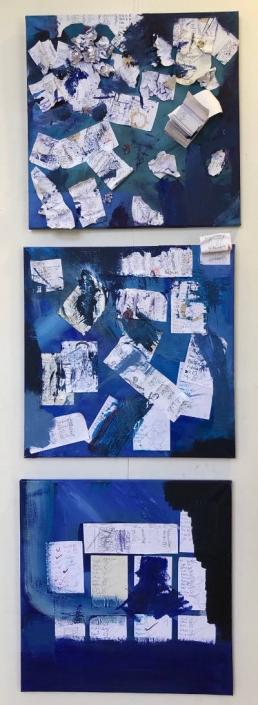
To-do
Partially inspired by On Kawara’s representation of time, this triptych is meant to clearly illustrate the transition from order to chaos in our everyday lives. The to-do lists are a relatable way of symbolizing an attempt at structure in our daily routines, which contrasts with the chaotic arrangement, state of the lists, and vivid background. The transition from order to chaos shows that while we desperately try to control everything possible, external chaos can still get the upper hand.
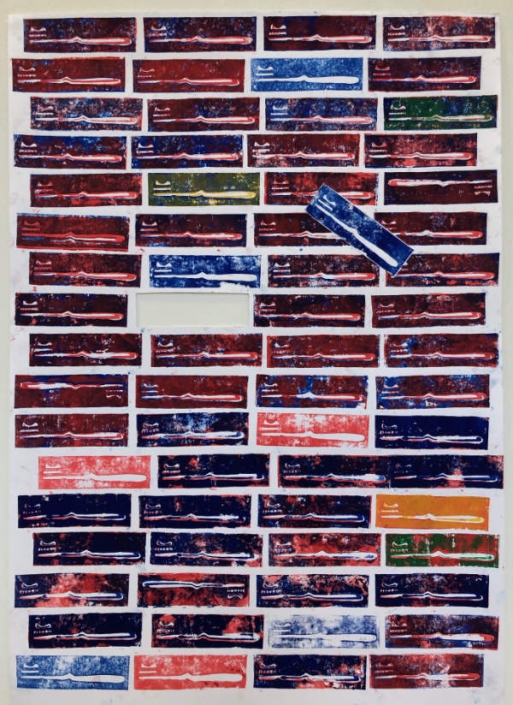
Daily Disruptions
The piece focuses on daily routine, portrayed by the toothbrush, one of the most common everyday objects. The colors, absence of colors and disruptions within the pattern are meant to irritate the viewer just like tiny disruptions in our daily habits do. The point of using a printmaking process is to represent how our routines are repeated every day, however a little bit different every day, just like a print. This piece was inspired by Andy Warhol’s prints of common objects like soup cans.
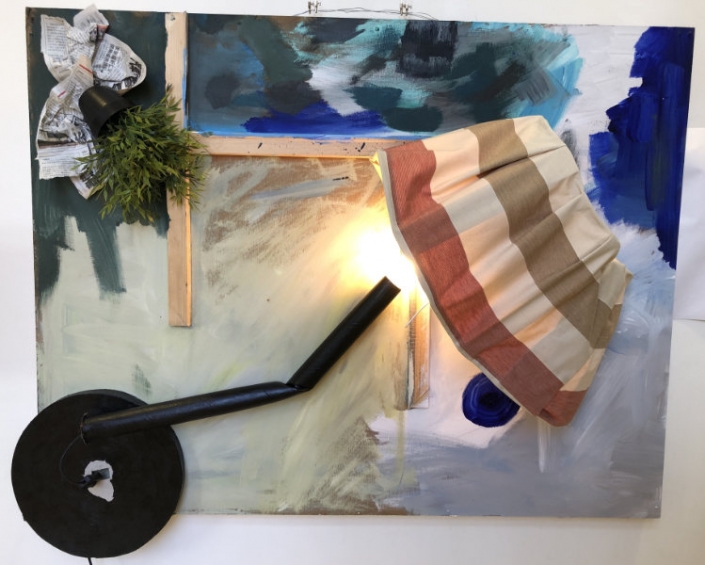
Deconstructed Desk
Inspired by Robert Rauschenberg’s Combines series in its use of found object and expressive brushwork. The piece represents a desk, but rather than having the items arranged in a neat order like on a proper desk, they are haphazard and broken but still functional. The piece explores the boundaries of functionality, and then combined with the deconstruction aspect portrays a disturbance in the ordinary.
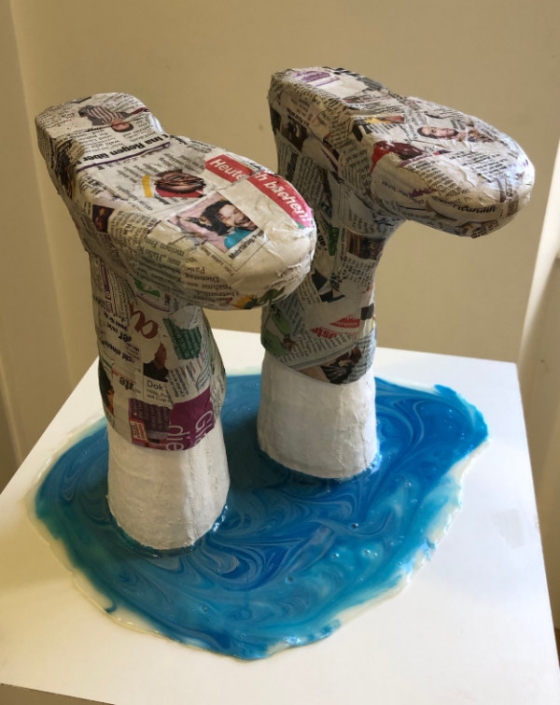
Upside down
Inspired by Robert Gober's Untitled Leg, this piece also represents daily life with a somewhat random and comical approach. The newspapers symbolizes the limited lifespan of any concept deemed relevant by the media. People might get influenced heavily by something superficial, which has the potential to make the whole world appear “upside down”. The humorous concept of the piece is meant to mock the relevance we give those exact events dramatized in the media.
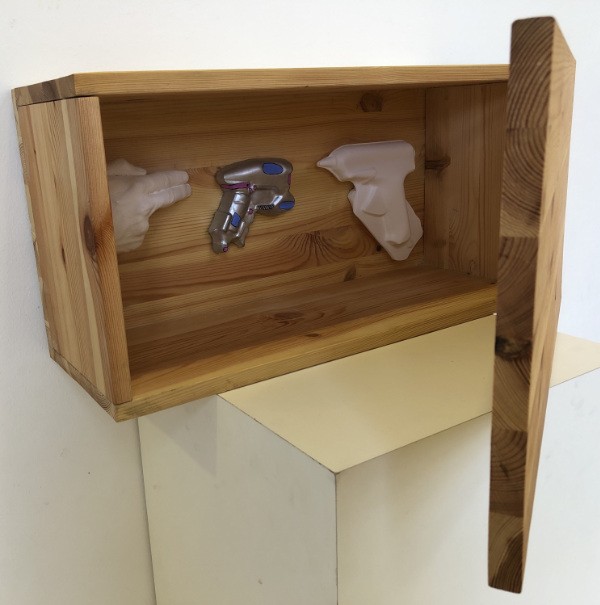
Gun Cabinet
This piece critiques the glorification of certain objects. Gun culture is portrayed in a playful and harmless way in order to highlight the irony of glorifying these undoubtedly dangerous but common objects. The cabinet was specially built to display the gun variations in a way that seems authentic, yet giving the objects a heightened status. The piece is interactive, as the closed cabinet is meant to be opened by the audience in order to create an effect of surprise and engagement.
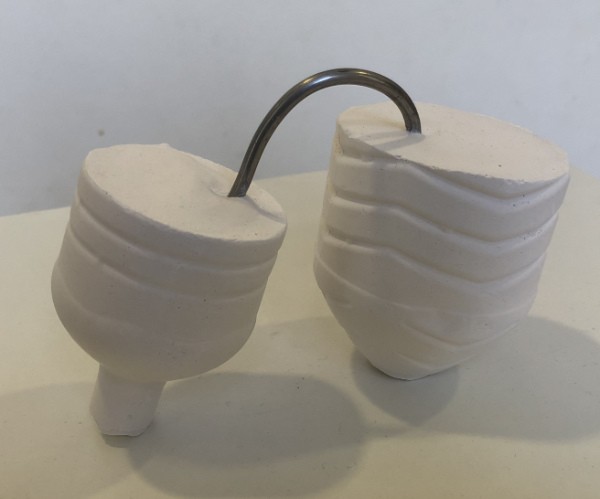
Together Forever
Inspired by Rachel Whiteread’s plaster castings of common objects, this piece solidifies the negative space within plastic bottles, and explores the concept of consumption. Negative or hollow spaces are often ignored or forgotten about in visual art, much like our ability as humans to forget where all of our used plastic objects go. Therefore, the title refers to the fact that because of the long lifespan of these everyday plastic objects we will be “together forever”.
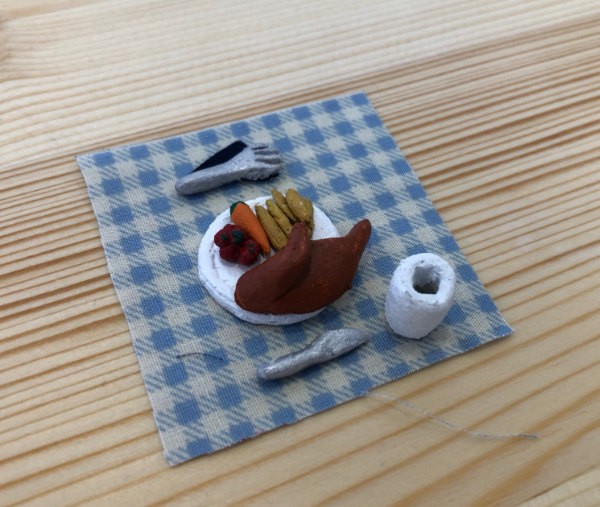
Dinner for One
Partly inspired by Claus Oldenburg’s use of scale, as he tends to do extremely oversized pieces, this piece explores the other end of the spectrum: miniature. Also crafting the table myself was meant to explore the tradition of furniture making deeply rooted in our culture. The absurdity in scale is meant to create a comical effect and invite viewers to crouch in for a closer look.
Julia
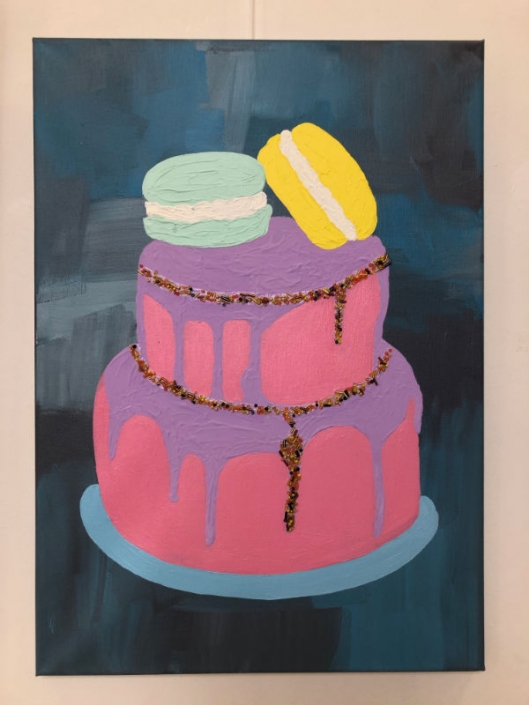
The Gluttony
Inspired by Wayne Thiebaud’s extensive use of cakes and sweets as subject matter, here the sin of gluttony is glorified with pretty pastel colors, as it might be on Instagram. Often advertisements make sugary products look attractive, fun and positive, while in reality in excess it causes addiction and harms our health. Many people my age are confused about food and nutrition due to mixed messages and misinformation causing them to pick up unhealthy habits.
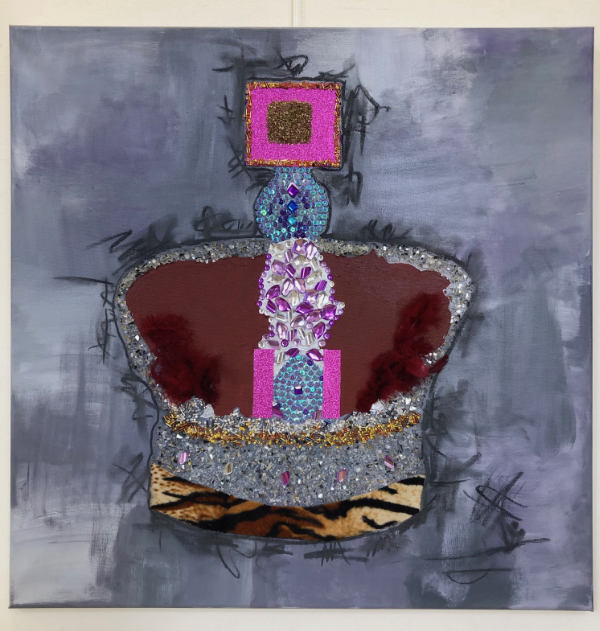
The Pride
Inspired by the real image of the crown jewels of England, the idea of monarchy in modern-day society seems to be prideful and outdated. Inspired by the mark-making techniques of Jean-Michel Basquiat, the work pokes fun at those living a life of extravagance and “extra”.
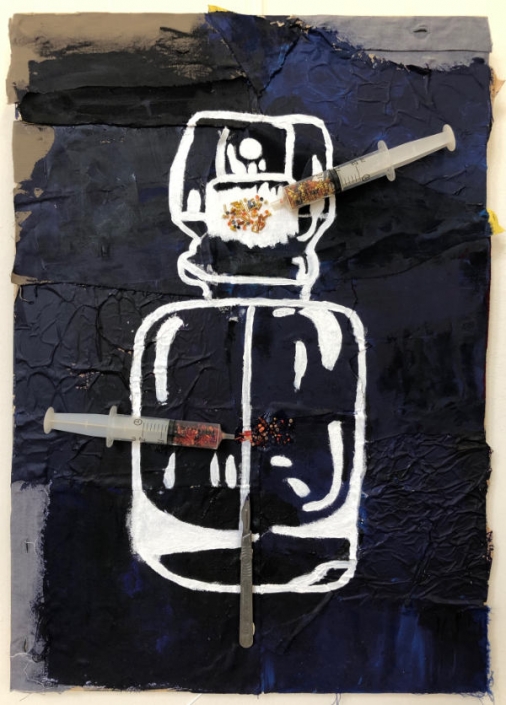
The Envy
Inspired by Robert Rauschenberg’s use of found objects on a two-dimensional surface, the painting represents dissatisfaction with one’s self. The perfume bottle surrounded by syringes and scalpels shows how one is capable of rejecting reality; trying to mask one’s self with plastic surgery and injections. My interest in this topic stems from the fact that most of the women in my community nowadays have experienced these procedures, by as young as age 21.
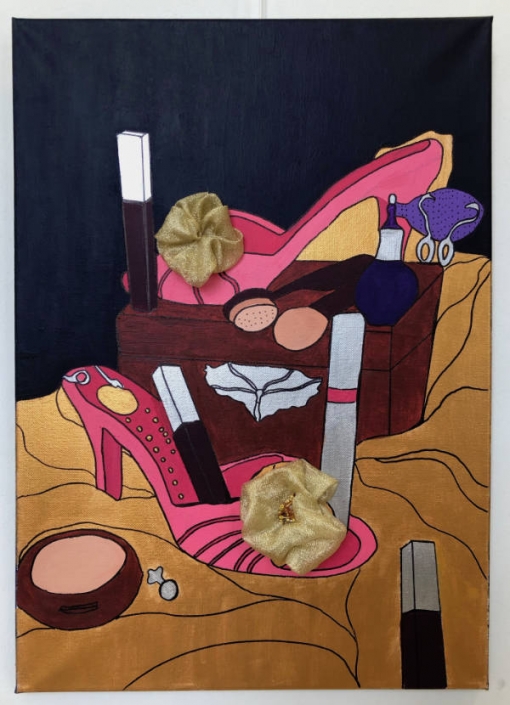
The Greed
Inspired by Dan Banino’s “Celebrity diets” still-life photographs, the piece represents the deadly sin of greed. Often, the desire to be better than others leads people to make unethical decisions as they prefer material goods over their spiritual and moral development. The painting’s style is reminiscent of Pop Art artists due to their exploration of commercialism in their subject matter.
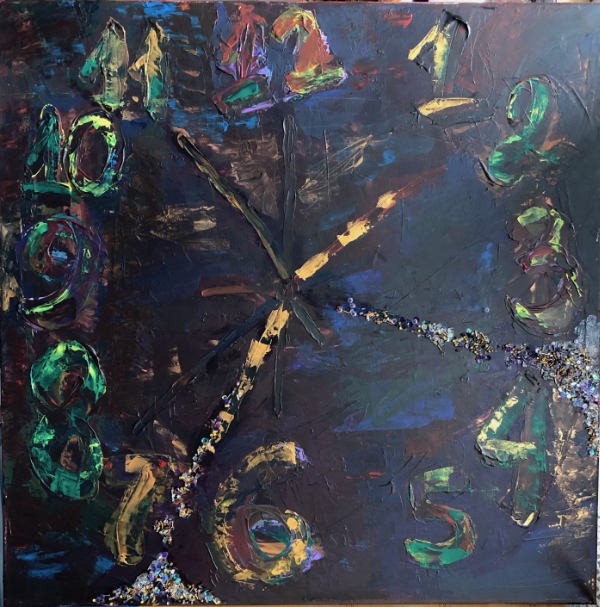
The Sloth
Inspired by Jasper Johns’ technique of paint layering, the intention of this painting is to represent time wasted in our lives. I am personally guilty of binging Netflix shows, just as many teenagers. If not being used wisely, the time will disappear and seconds will flow away just as the beads do on the surface of the clock. As sloth is a negative trait, darker, muddied colors were used, while the value of the moments in our lives is represented with colorful beads.
Philipp
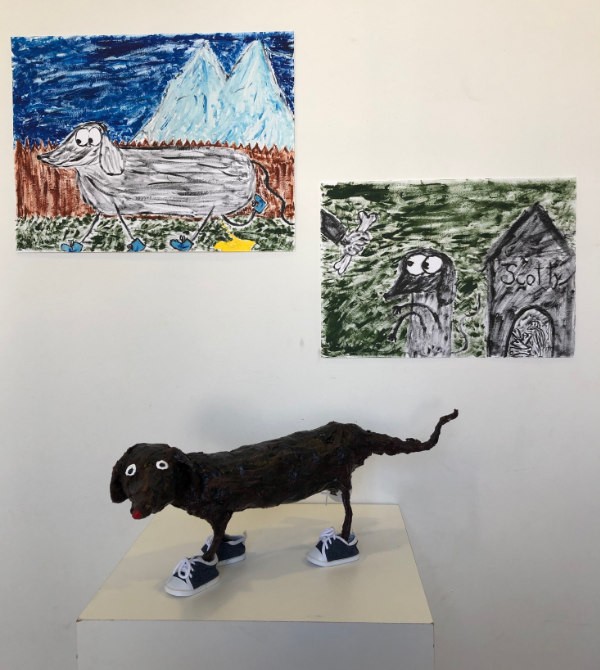
Scotty-Sausage-Dog (Series)
Scotty the dog is the biggest sculpture from this series and he is also the last. In my oil and acrylic paintings, the dog often has his leg up and urinates on different objects so I decided to build a sculpture which would resemble my paintings. The dog wears sneakers on each foot and the back right leg is up to amuse people.
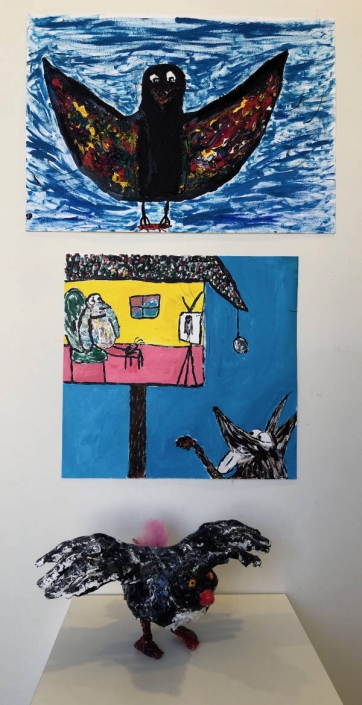
Handy-Bird (Series)
The wings from this bird are made out of my plastered hands which gives the sculpture the humanistic touch which all of my other sculptures also include. It was challenging to make the bird stand by itself without falling, only standing on two feet. The paintings are connected to the sculpture and should show how the bird lives his daily life.
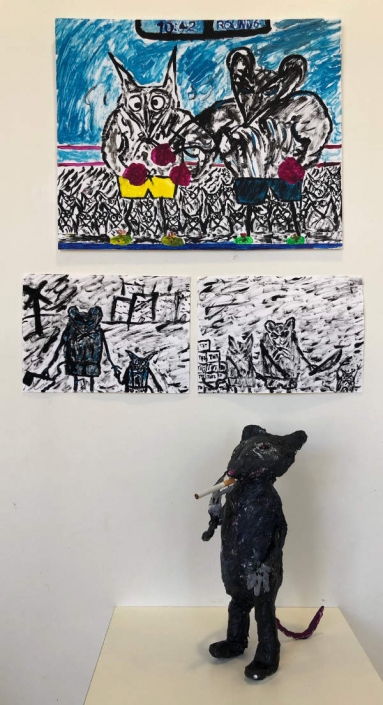
Ratter Smoker (Series)
This sculpture of the rat and the paintings behind the sculpture should show the evilness of the animal. I tried to make the sculpture look sinister by making the rat smoke and I added red and purple to the sculpture’s eyes and also to the paintings to give the motif a scary look. In movies, often criminals smoke so I decided it would make the sculpture look like a criminal as well, I also added scars to the sculpture and to the connecting paintings.
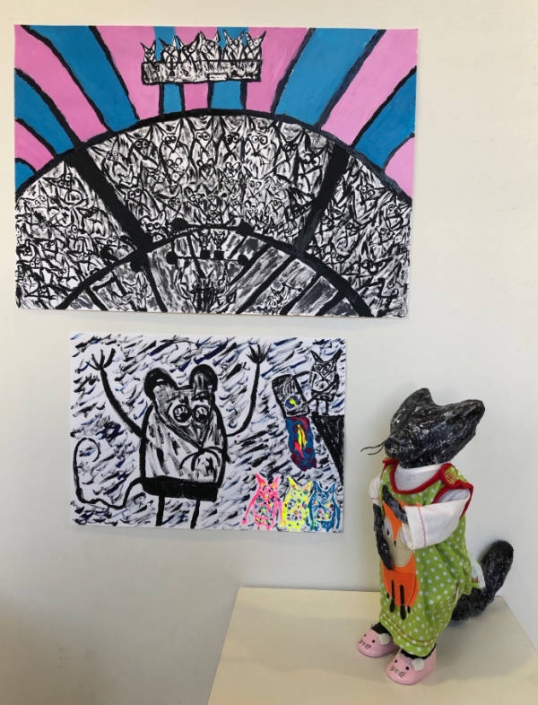
Mr Fox dresses up (Series)
This is my favorite motif out of this series. Mr. Fox himself can be seen in real life wearing a costume connected with the art works of him performing several different activities. The paintings should tell the viewer a story about the fox’s life and his interactions with other animals. I choose to make the animal wear doll clothes to build a contrast between good and evil but also to amuse the audience.
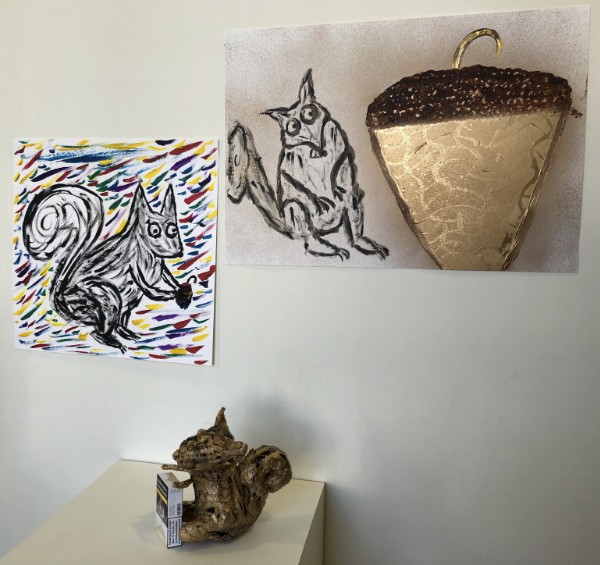
Sunny-Squirrel (Series)
The squirrel sculpture is the only one from the series which is fully spray painted in gold. I also used spray paint in one of the paintings. The gold color makes him seem more important, and rich. The squirrel is holding a cigarette pack because I wanted to show funny relationship between the size of the pack and size of the squirrel.
Marija

Split (triptych)
This artwork examines the phenomenon of the condition of split personalities. Minor changes in the person’s face, depending on the angle of drawing, show the evolutionary changes in human consciousness. The red background symbolizes the anxiety and turmoil caused by the condition.
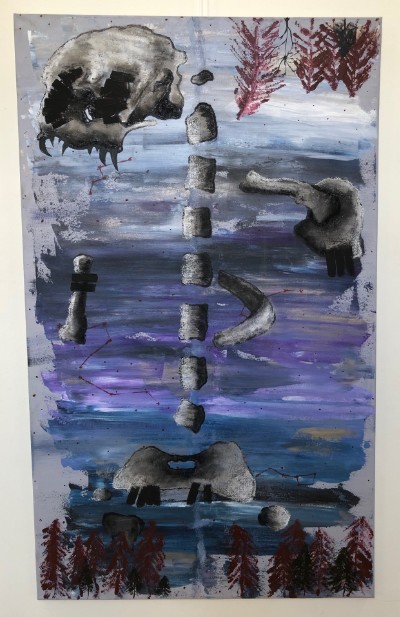
Hybrid
This artwork reflects internal and external conflict, and the conflict between human and animal instinct. There is a literal conflict between man and animal, in which one destroys the other, as a result of which both species can die out if they do not change their understanding of existence in one world. The work also explores human and animal origin, in which people try to balance the reptilian brain and the neocortex system.
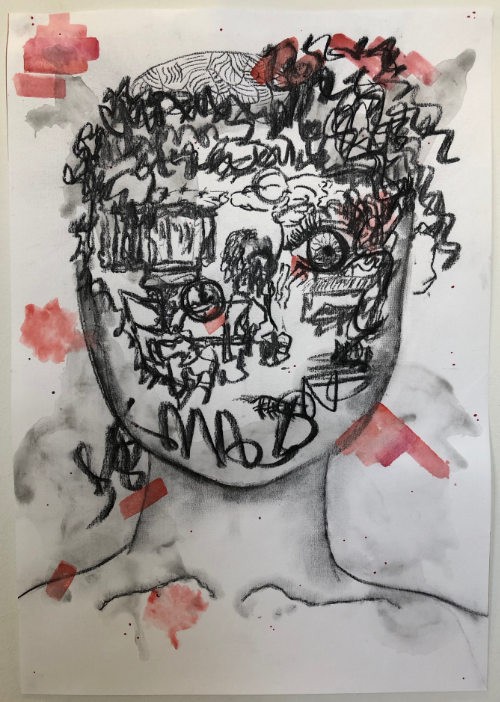
Dementia
This painting studies the condition of dementia. A person suffering from dementia often begins to forget acquaintances, relatives, native places, but in the mind images of the past brightly reemerge, which is represented in the expressive charcoal drawings here.
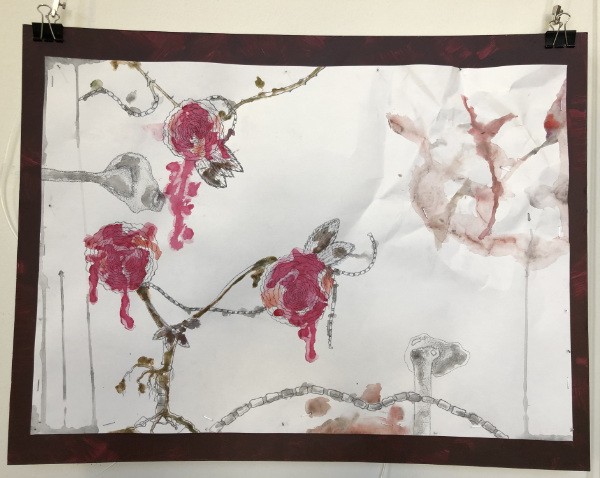
Duality
The combination of natural flowers and the skeleton reflects the indivisibility of death and life, this is the condition of dualism in all living things. The vague silhouettes painted in watercolor show the ephemeral nature of life and death.
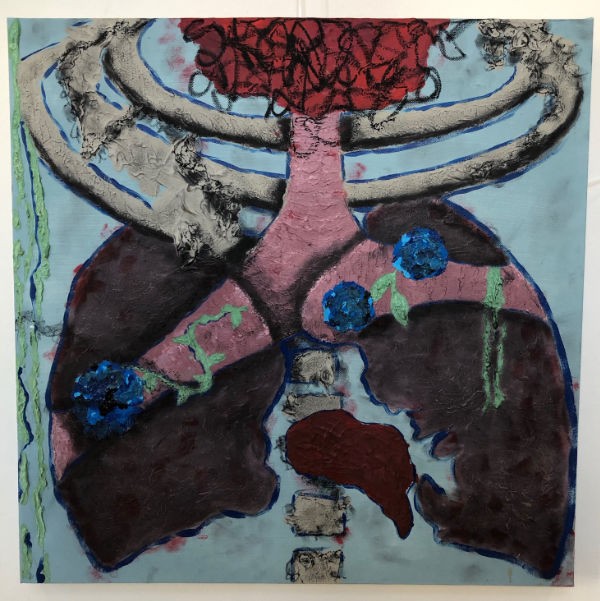
Erosion of Lungs
The painting is a representation of erosion, it portrays the developing cancer occurring in the lungs. The disease is represented by the flowers and green shoots, as if the metastases were blooming as flowers. Such symbolism comes from my native language’s metaphor “blooming illness”. The artwork is inspired by Egon Schiele’s bold outlines around the main subjects and his representation of illness through color.
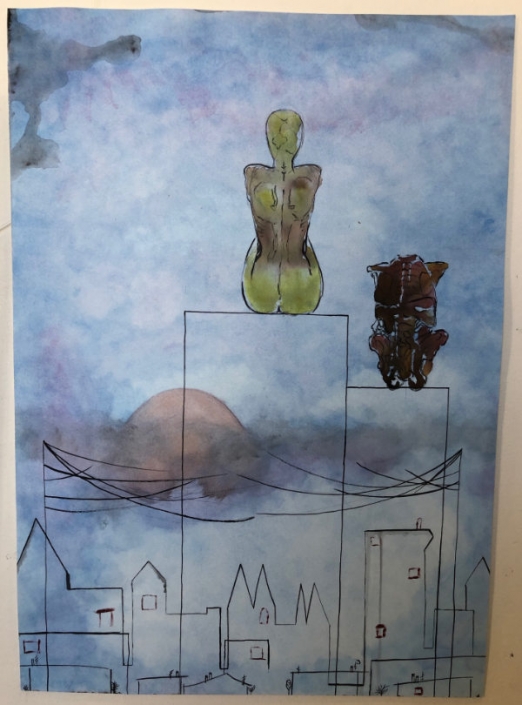
Existential Loneliness 2
This painting was based on the following Orson Welles quote: “We are born alone, we live alone, we die alone. Only through our love and friendship can we create the illusion for the moment that we are not alone.”
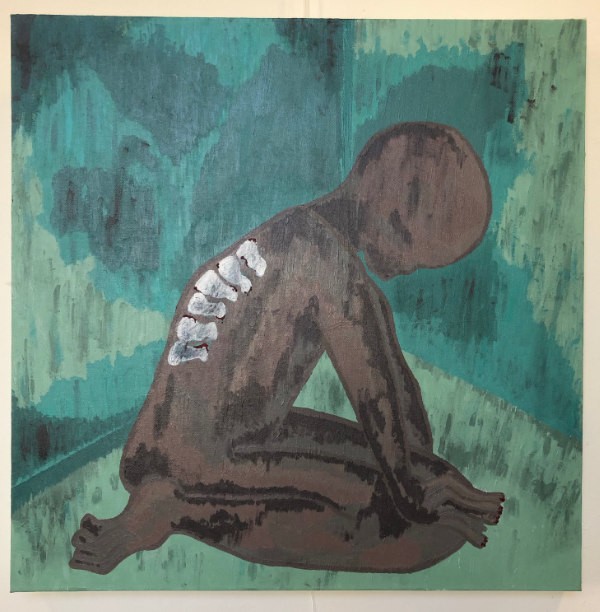
Existential Loneliness
The art-piece was inspired by the quote of the famous American psychiatrist Irvin D. Yalom. “Existential loneliness is associated with the loss of not only biological life, but also the whole world - rich, thought out to the details. This world does not exist anywhere else - only in our consciousness.” The lack of color and the body’s dysmorphic shape in the confined space represents the mental condition of the existential loneliness described in the quote.
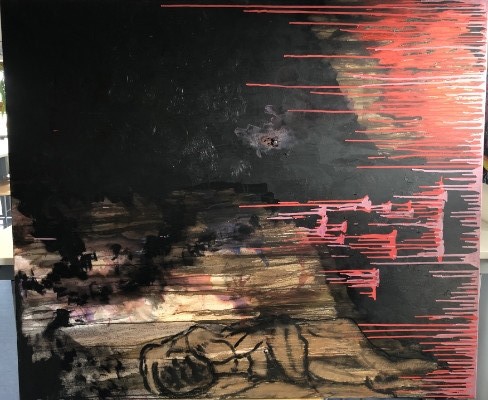
Stigmatization
The painting depicts the weakness of a person who is under the pressures of society. The black paint symbolizes the dogmatic expectations of society in relation to the individual. The figure at the bottom occupies the last bright zone of the artwork, the "safe" zone. The compressed figure is trying to physically hide from the stigmatization engulfing him.
Chiara
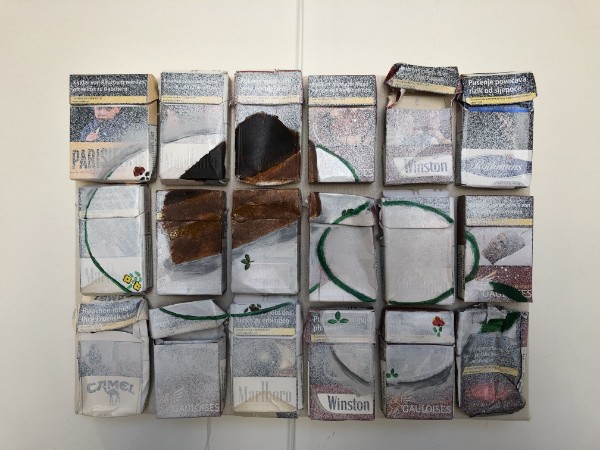
Teatime
A slice of Sachertorte cake and a cup of Milange coffee is the most common treat combination for Austrian teatime. However, Austrian is also famous for its smoking habits and is commonly referred to as “Europe’s ashtray”, due to delaying public smoking laws as long as they could. And what goes better with a coffee than a cigarette. Combining these social habits into one artwork represents both the good and the bad side of a day-to-day Austrian life.
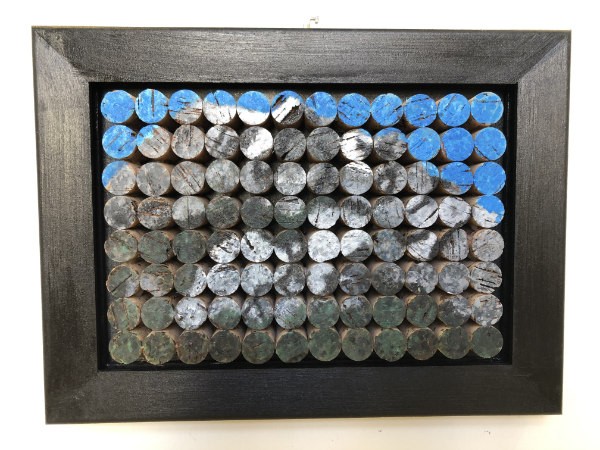
The Peak of Culture
This piece made entirely of corks represents the significance of wine as a part of Austrian culture. My personal Austrian roots are represented through the mountain called "Traunstein", painted with a dotted technique called Pointillism. This mountain is a nostalgic connection to my Austrian culture because I grew up next to it and took walks on it daily. It represents my personal connection to my culture as a small component within the bigger picture of Austrian culture.
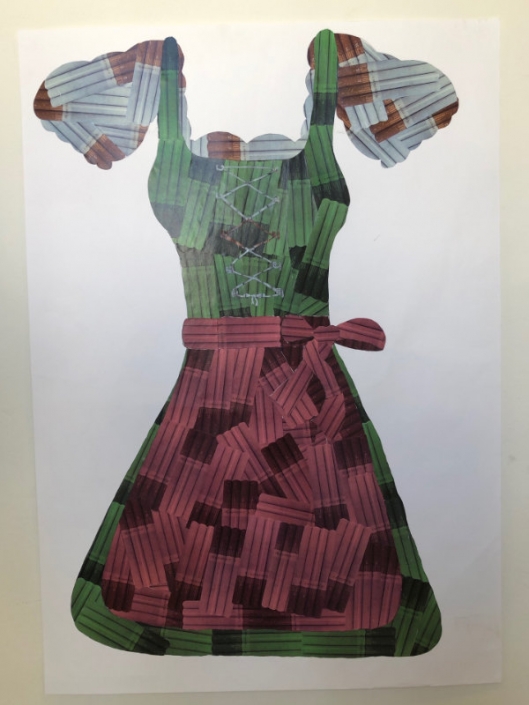
Dirndl
This piece represents two contrasting parts of a culture, the positive and the negative. The positive is represented through the dirndl, a traditional Austrian costume for women used for special occasions and celebrations like weddings. The negative aspect is represented with cigarettes, as Austria has strong smoking habits and no reservations about smoking in public places.
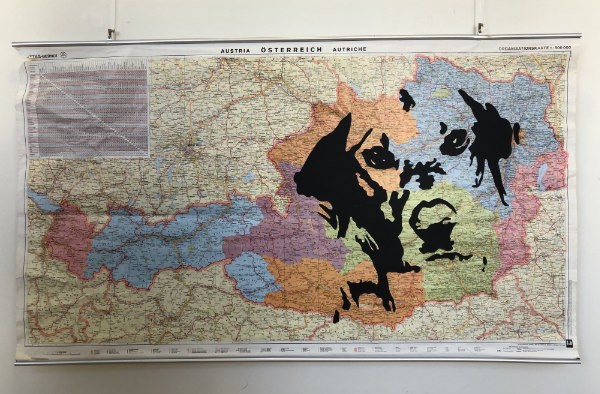
Nala
Inspired by Jasper Johns’ use of maps, this piece is not only a portrait of my dog Nala but a representation of how much Austria loves dogs. Although one of the biggest complaints among residents is dog poop on the sidewalk, dogs are cherished here and are allowed inside trams, restaurants, and shops. This can be seen by the statistic of dogs who live in Austria which is at about 830 000. Dogs are seen as part of the community and welcomed almost everywhere.
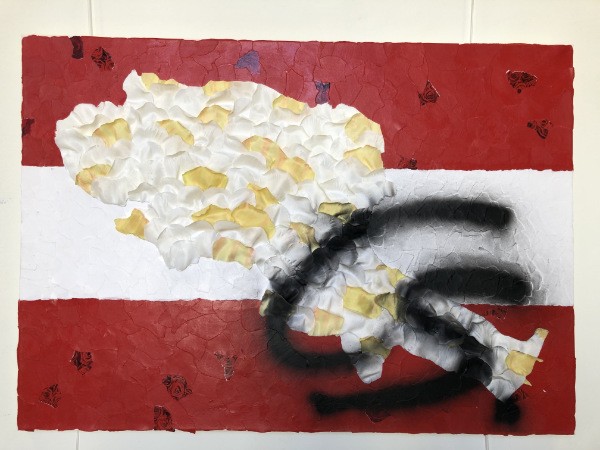
Graffiti
Inspired by Jasper Johns’ use of subject matter such as flags and maps from his home country, this piece not only represents Austria with the bold Austrian flag collage in the background, but also my hometown Baden. The arrangement of the rose petals in the middle represents a map of Baden, which is a beautiful, garden filled part of Austria. In contrast, the graffiti tag of my initials shows how unappreciative and thoughtless some residents can be and represents the negative side of a culture.

Heide
Many Austrians enjoy and take advantage of the beauty of nature. My personal connection to nature is represented through the oil painting of the picnic bench and the landscape on one of the hills in the forest called “Heide”. However, many people destroy this place of peace and beauty with the consumption of alcohol. Many picnic benches are surrounded with beer cans, which destroys the beauty of nature.
Polina
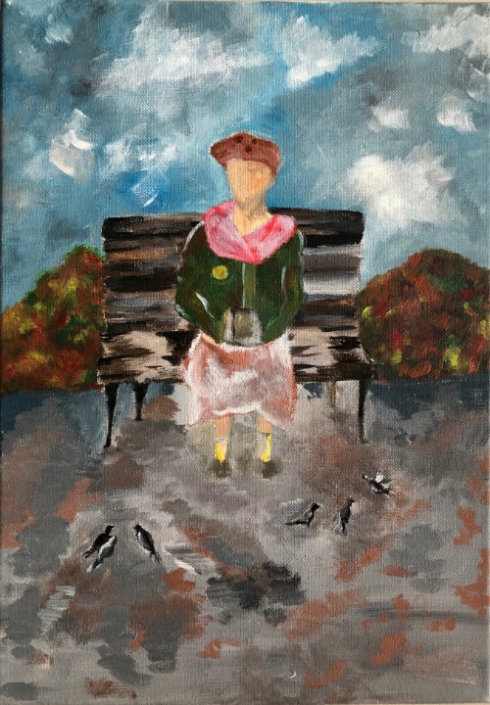
Case of Solitude
Inspired by Edward Hopper’s simplistic painting style and his representations of loneliness, his work reminded me of my grandmother who spends most of her time alone, because of her advanced age most of her friends have passed on. Here the figure sits in solitude attempting to befriend the pigeons in order to have some company. I dedicated a piece to her because she is the best reflection of me. In my opinion our ancestors play a big role in our perceptions, and she helped my parent raised me.
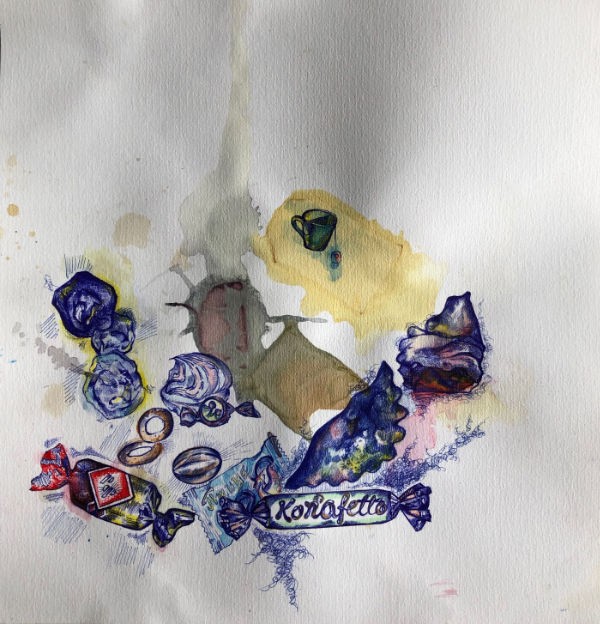
Tea case
The art work is a result of my thoughts about the cultural impacts of daily food patterns. Both of my mother’s (Ukrainian) and father’s (Russian) cultures have a tradition of having tea with family as a part of the day, this time is mostly devoted to conversations among the family. In this case this tradition left traces (I literally used spilled tea as a metaphor) on my up-to-date identity. Russian and Ukrainian popular sweets highlight our daily habits.
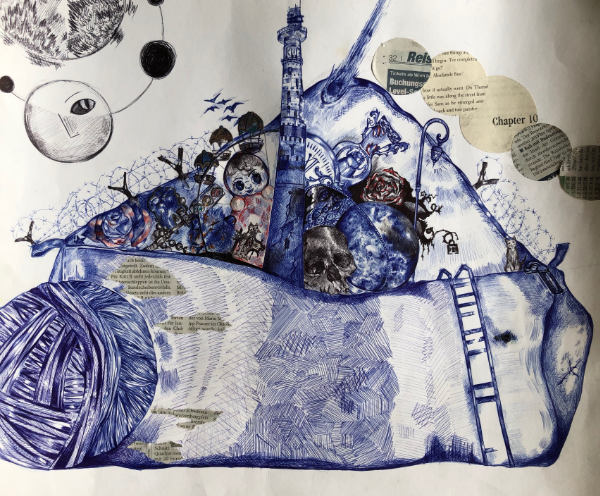
My Pencil Case
The work was inspired by Frida Kahlo’s painting What I Saw in the Water, where all the elements of her life were floating on the surface of the water. My intention was to hide my small world inside a pencil case, representing all the things I find important and that describe my identity as a person. Objects include landmarks and traditional objects of my home country, as well as things that interest me, and objects from my daily life.
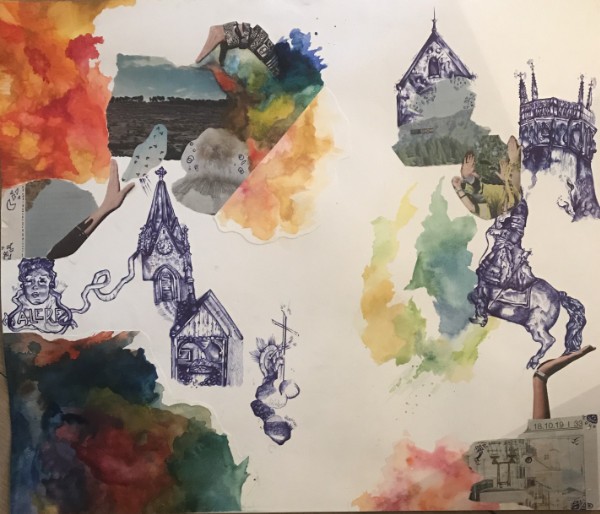
Environmental case
The architectural environment that surrounds me in my current daily life in my new country differs from my childhood memories. Austrian architecture creates a miraculous environment but it is only a fragment of my identity, that is why I chose to represent it in a Surrealist fashion. The central part of the artwork is left empty to leave an opening for my future experiences.
We welcome the opportunity for prospective students and their families to visit AMADEUS Vienna and learn more about our unique programme and inspiring school environment. Contact our Admissions team to ask your questions or schedule a tour.
